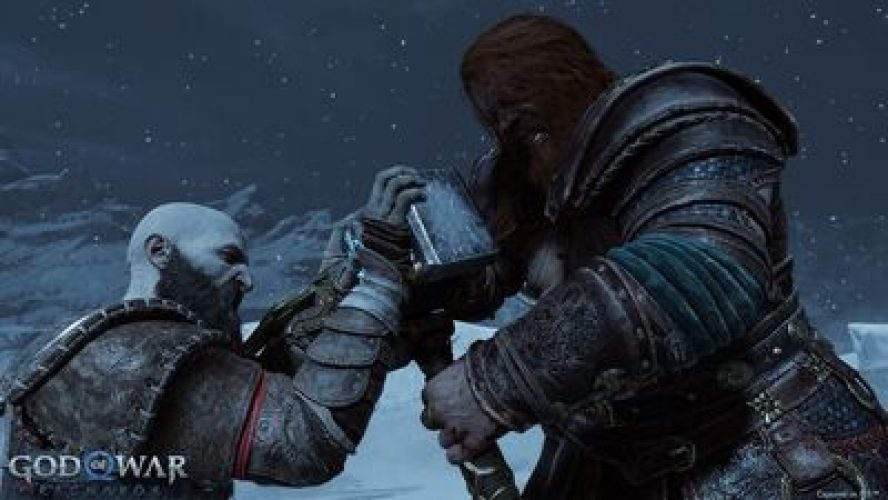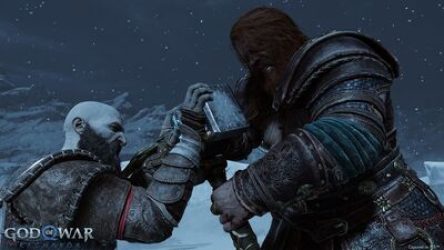“God of War” has been one of Sony’s most successful franchises of the modern era, both critically acclaimed and commercially massive. You can’t go to a pop culture convention without seeing Kratos somewhere—he’s a character who has transcended mere video game hero to become iconic. The newest game in a series that started way back in 2005 leans into the legacy and fate of Kratos, asking questions that this hack-and-slash series couldn’t have imagined way back on the PS2. The writing in the “God of War” series has gotten more ambitious as the graphics have improved with each generation of consoles and “God of War: Ragnarök” sees an older Kratos and his son Atreus digging into ideas of fate and regret in ways that are thematically rich and dense. In many ways, this is the “Logan” of the “God of War” series in the sense that it sees an older hero questioning the bloodshed that has brought him to this place and possibly wondering how he will write his final chapter. It’s a fascinating narrative enriched even further by the way the writers bring iconic characters like Thor, Odin, Heimdall, and others into the world of this game, giving everything that happens a sense of gravity and importance. The word Ragnarök refers essentially to the end of days, and everything about this game rises to the challenge of that title. This is easily one of the best games of 2022.
“Ragnarök” opens three years after the end of the phenomenal 2018 game, which was just titled “God of War”. It has been “Fimbulwinter” for three summers, a great ice age whose end foretells the beginning of Ragnarök. So much of this game builds on what happens in the last one that the menu screen allows for a recap to be viewed to catch players up on the essential details. Thor seeks revenge for the deaths of his half-brother Baldur and his two sons Modi and Magni. Thor’s papa Odin, wonderfully voiced by Richard Schiff, gets involved in the action, and, of course, there’s the little fact that Atreus is also known as Loki to contend with.
After an explosive prologue, the action of “Ragnarök” kicks off with Kratos and Atreus traversing the nine realms to basically gather their own God-like Avengers to battle the end of the world, reuniting them with characters the franchise has incorporated before and introducing some new ones. They are forced to rescue, Tyr, the Norse God of War, and convince Freya to return to the fold. Along the way, the combat mechanics grow with the intensity of the game. However, “Ragnarök” gives players a remarkable set of tools right from the very beginning, perhaps recognizing that most will have played the last game and don’t want to take hours before they get their favorite toys back in the sandbox. So, from the beginning, Kratos is throwing his Leviathan Axe and unleashing his Blades of Chaos. However, this game incorporates a great deal more action outside of Kratos too, including playable chapters as Atreus, who becomes a more richly drawn character in this game than the last one.
In fact, it’s through the eyes of Atreus that a lot of the action of “Ragnarök” unfolds as he’s the one torn between his father and Odin as the end of the world looms. He’s heard the stories of what’s to come but refuses to believe that these things are outside of his control. He also has a deeper conscience than his grunting father, but the entire game plays with issues of regret that the franchise hasn’t really seen before. Mimir, the talking head that accompanies Kratos and imparts knowledge and wisdom, plays more like a conscience to Kratos too, even asking the big question about what they’re actually trying to save by killing so many enemies. When does it stop being worth saving if it requires so much carnage?
All of this plays out against one of the most gorgeously rendered backdrops in video game history. From the icy climate of Kratos’ home to varied landscapes of water and nature, “Ragnarök” is a stunning game to watch, rich in detail in ways that can be entrancing. The game flows so smoothly from cut-scene to combat that it never breaks the narrative in ways that can be so distracting as other games try to tell their stories. And the physics of the combat are breakthrough for the PS5 generation. The new PS5 controller with its haptic design and speaker gives everything more weight. You feel the rumble of a battle, the water under your oar, or the snow under your dogsled. It makes everything so much more immersive.
Here at RogerEbert.com we try to cover games with cinematic influences and “God of War: Ragnarök” feels like the kind of epic blockbuster we only see once or twice a year. It’s the “Lord of the Rings” or “Avengers: Endgame” for the PS5 generation, a game that takes place across multiple settings and ties together unique, fully-drawn characters—the one thing that feels most different about this game compared to the rest of the franchise is how much time is spent away from Kratos, giving it a more “Fellowship” feel than a traditional hero’s journey.
Most of all, it is a game in which one can tell no corners have been cut. There’s not a single mission in the nearly 40 hours I spent in this game that felt like fat that needed to be trimmed. And when the game ends with an expectedly glorious battle, the narrative then settles back into the characters that players have come to know and love for a beautiful epilogue. And will miss until this God rises again.
A review copy of this title was provided by Sony.
“God of War” has been one of Sony’s most successful franchises of the modern era, both critically acclaimed and commercially massive. You can’t go to a pop culture convention without seeing Kratos somewhere—he’s a character who has transcended mere video game hero to become iconic. The newest game in a series that started way back in 2005 leans into the legacy and fate of Kratos, asking questions that this hack-and-slash series couldn’t have imagined way back on the PS2. The writing in the “God of War” series has gotten more ambitious as the graphics have improved with each generation of consoles and “God of War: Ragnarök” sees an older Kratos and his son Atreus digging into ideas of fate and regret in ways that are thematically rich and dense. In many ways, this is the “Logan” of the “God of War” series in the sense that it sees an older hero questioning the bloodshed that has brought him to this place and possibly wondering how he will write his final chapter. It’s a fascinating narrative enriched even further by the way the writers bring iconic characters like Thor, Odin, Heimdall, and others into the world of this game, giving everything that happens a sense of gravity and importance. The word Ragnarök refers essentially to the end of days, and everything about this game rises to the challenge of that title. This is easily one of the best games of 2022. “Ragnarök” opens three years after the end of the phenomenal 2018 game, which was just titled “God of War”. It has been “Fimbulwinter” for three summers, a great ice age whose end foretells the beginning of Ragnarök. So much of this game builds on what happens in the last one that the menu screen allows for a recap to be viewed to catch players up on the essential details. Thor seeks revenge for the deaths of his half-brother Baldur and his two sons Modi and Magni. Thor’s papa Odin, wonderfully voiced by Richard Schiff, gets involved in the action, and, of course, there’s the little fact that Atreus is also known as Loki to contend with. After an explosive prologue, the action of “Ragnarök” kicks off with Kratos and Atreus traversing the nine realms to basically gather their own God-like Avengers to battle the end of the world, reuniting them with characters the franchise has incorporated before and introducing some new ones. They are forced to rescue, Tyr, the Norse God of War, and convince Freya to return to the fold. Along the way, the combat mechanics grow with the intensity of the game. However, “Ragnarök” gives players a remarkable set of tools right from the very beginning, perhaps recognizing that most will have played the last game and don’t want to take hours before they get their favorite toys back in the sandbox. So, from the beginning, Kratos is throwing his Leviathan Axe and unleashing his Blades of Chaos. However, this game incorporates a great deal more action outside of Kratos too, including playable chapters as Atreus, who becomes a more richly drawn character in this game than the last one. In fact, it’s through the eyes of Atreus that a lot of the action of “Ragnarök” unfolds as he’s the one torn between his father and Odin as the end of the world looms. He’s heard the stories of what’s to come but refuses to believe that these things are outside of his control. He also has a deeper conscience than his grunting father, but the entire game plays with issues of regret that the franchise hasn’t really seen before. Mimir, the talking head that accompanies Kratos and imparts knowledge and wisdom, plays more like a conscience to Kratos too, even asking the big question about what they’re actually trying to save by killing so many enemies. When does it stop being worth saving if it requires so much carnage? All of this plays out against one of the most gorgeously rendered backdrops in video game history. From the icy climate of Kratos’ home to varied landscapes of water and nature, “Ragnarök” is a stunning game to watch, rich in detail in ways that can be entrancing. The game flows so smoothly from cut-scene to combat that it never breaks the narrative in ways that can be so distracting as other games try to tell their stories. And the physics of the combat are breakthrough for the PS5 generation. The new PS5 controller with its haptic design and speaker gives everything more weight. You feel the rumble of a battle, the water under your oar, or the snow under your dogsled. It makes everything so much more immersive. Here at RogerEbert.com we try to cover games with cinematic influences and “God of War: Ragnarök” feels like the kind of epic blockbuster we only see once or twice a year. It’s the “Lord of the Rings” or “Avengers: Endgame” for the PS5 generation, a game that takes place across multiple settings and ties together unique, fully-drawn characters—the one thing that feels most different about this game compared to the rest of the franchise is how much time is spent away from Kratos, giving it a more “Fellowship” feel than a traditional hero’s journey. Most of all, it is a game in which one can tell no corners have been cut. There’s not a single mission in the nearly 40 hours I spent in this game that felt like fat that needed to be trimmed. And when the game ends with an expectedly glorious battle, the narrative then settles back into the characters that players have come to know and love for a beautiful epilogue. And will miss until this God rises again. A review copy of this title was provided by Sony. Read More


